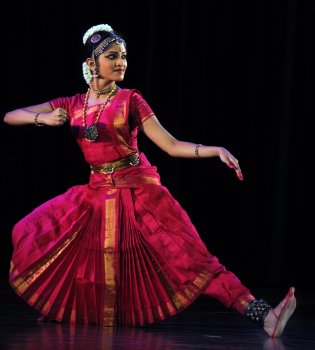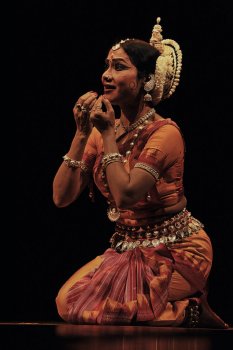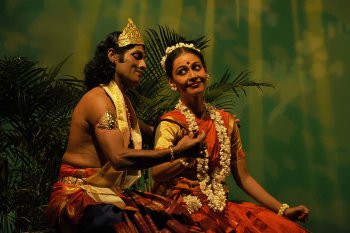
|   |

|   |
Music Academy Dance Festival: Day 5 - Veejay Sai e-mail: vs.veejaysai@gmail.com January 23, 2014 That twitch in the brow The fifth morning of the Academy’s festival opened with a solo performance by Sukanya Kumar. Her bio in the Academy’s brochure says she has been trained in both Bharatanatyam and Kathak. She is a graduate of the Sri Rajarajeshwari Bharatanatya Kala Mandir from Mumbai. She is currently continuing her dance under Priyadarsini Govind and like every second dancer in Chennai, studying abhinayam under veteran Kalanidhi Maami. With all this glorious bio, one expected Sukanya Kumar to give a blast of a performance on stage. Instead she danced with a perpetual frowning twitch in her eyebrows and gave her audiences the same, by the end of her performance.  Sukanya Kumar Photo: Thanthoni Sukanya began her performance with an alarippu infused with a Thiruppugazh of Arunagirinathar set to tune by Aadith Sheshadri. Her guru Priyadarsini does a good job of this piece “Muthaitharu” in many of her recitals. She continued into her main piece, the famous Tanjore Quartet varnam “Saami ninne kori.” Why don’t dancers of the junior most slot stick to what they give the Academy to publish in the brochure? Is it that they fall short of all those many rehearsals that prepare them to perform? Or is it sheer arrogance not to perform what they have committed to? Either ways, it makes no sense to waste the Academy’s brochure space by committing to something and doing something else completely different. Sukanya performed the varnam with a much-rehearsed hesitation. Her sancharis were like dots that remained unconnected in the longer narrative of the content of the composition. The saving grace was Arun Gopinath’s soulful singing. Over the years, he has also bettered his pronunciation and come out as a fantastic singer for dance. His elaboration of ragam Shankarabharanam in “Sadaa nannelukora” was outstanding. Even in the other ragams in the composition like Athana and Kalyani, Arun gave his full self to the rendering. It was more delightful to listen to Arun’s singing and Sigamani’s violin. Sukanya continued her performance into the popular padam “Indendu vachchitivi raa” by Melattur Kashinathayya in ragam Surutti and mishra chapu talam. Here Sukanya began her abhinayam well but eventually got into a zone of vagueness. She displayed patches of brilliance. After a Purandaradasa Devaranama that went on for long, Sukanya finally concluded her performance with a thillana. Sukanya needs to work a lot more to prove herself as a better dancer. She has unutilized grace and potential that is waiting to be explored. Under the guidance of a good guru, she will blossom forth into one of the more talented youngsters around. Rama’s humble servant For some strange reason, it has been a dwindling affair for male dancers in the Music Academy’s annual festival calendar. The recently conducted ‘Purush’ festival for male dancers was an excellent boost to their collective image as being nowhere less in this art form from their female counterparts. The mid-morning slot performance was by Bangalore-based Sathyanarayana Raju. A student of late guru Narmada and Maya Rao’s Natya Institute, Sathya has grown from strength to strength as a soloist in the last few years. His was the first of the two male solo performances at the Academy’s festival this season.  Sathyanarayana Raju Photo: Thanthoni Sathya opened his performance with a Pushpanjali set to ragam Kadyonkanthi composed by Tirumale Srinivas and set to adi talam. It took us a while to get to us that this was a rather new name being used for an already existing ragam. It hails from the 34th Melakarta ragam Vagadeeshwari. It would be interesting to study the structure of this ragam further considering it is not listed in the eight main Janya ragams of Vagadeeshwari. Sathya continued into his main piece, which was the varnam “Devadi deva Nataraja,” a composition of Veena Sheshanna set to ragam Shanmukhapriya and adi talam. Clean and clear lines, energetic leaps and well-synchronized phrases were notable in the varnam. The sancharis in “Chidambara naathane kanakasabheshane jagadeeshane” were perfected to display the choreographic genius of his late guru Narmada. However, at a later part, while portraying the navarasas, Sathya began with the description of Shiva and one thought he would continue on that note. His portrayal of the entire sequence of the nine rasas seemed severed from the main flow of the varnam and ended up breaking the threads of a clean thought process that came by till that point. If it were knit into the account, the continuum would be more enjoyable as his portrayal of other leelas of Shiva were laudable. Sathya continued his performance into a Devaranama of Purandaradasa in the praise of lord Hanuman. This was probably the highlight of his whole performance. “Hanumantha deva namo” exhibited the best of Sathya’s abilities. Be it the simple well-known tales of Hanuman or a smart way of utilizing ragam Shivaranjani to describe the mood of melancholy of Sita captured in Ravana’s Ashoka vatika, Sathya’s best explored his ideas of choreography. Towards the end of the piece, like Hanuman tears his heart open to show Rama in it, one got to see the best of Sathya’s dance and abhinayam in this item. This piece was made for him and he gave his full into its performance. With the entire performance on one side and this one piece on the other, Sathya concluded his recital with a thillana. What stayed etched in the memory, far from all the acrobatics of nritta or the Shiva Bhakthi was the piece on Hanuman. Like Hanuman was the ideal devotee to Rama, one found Sathya’s experience of rasaanubhava an ideal experience for a good performance. Sculpturesque stances What does one describe Sujata Mohapatra as? A fleeting imagery of aesthetic sensuality or an idea that could best express itself in the form of a dancer? Whatever anyone agrees or disagrees, Sujata is one of the finest exponents of Odissi we have in the world today. She gathers this honour with her own right in addition to being the daughter-in-law of the legendary Kelucharan Mohapatra. Whenever and wherever Sujata performs, she leaves her audience absolutely awestruck; the kind of effect the legendary Sanjukta Panigrahi used to have ages ago. Same was the effect at her performance in the Academy.  Sujata Mohapatra Photo: Siddharth Chandrasekar Sujata began her performance with an obeisance to the mother goddess after the obligatory invocation to lord Jagannatha. Utilizing motifs from the Devi Bhagawat, the Durga Stuti was tuned to a Mangalacharan, set to a ragamalika and a talamalika. “Jayanti magala kali, bhadra kali kapalini” sang Rupak Kumar Parida in his sonorous voice filling the whole Academy hall with chants as Ramesh Chandra Das played on his melodious flute. For her main item, Sujata performed a pallavi in raag Bilahari. Set to tune by Pt Bhubaneswar Mishra and choreographed by guru Kelucharan Mohapatra, the whole slow process of construction begins with ‘the tharitha jhena’ before it ascends into a higher tempo. Precision in geometry added to the graceful movements of her dance, Sujata’s performance was remarkable. She continued her performance with the ashtapadi “Kuru yadu nandana.” This seemed to be the favourite ashtapadi for the festival, considering we were all watching it for the third time. The only difference was the outstanding choreography by Kelubabu. One could never go wrong with this. Opening with her back facing the audience, and turning front before she sat on the stage, as Sujata explored the abhinayam of the nayika who has had a night long of passionate exchanges with Krishna one could see the erotic sculptures of the ancient temples of Odisha come alive. Totally involved in her poise with a hint of gesturing, a wink of romance and a delicate smile of flirtation, one could see how beautifully this composition was treated by Kelubabu. This was easily the best rendering of this particular ashtapadi followed closely by Meenakshi’s in the Bharatanatyam style. It had all the elements of sensuality without being obscene or loud about it. Srinibas Satpathy’s flute added magic to the entire mood of the song. Sujata concluded her performance with ‘Sabari,’ an excerpt from the Ramacharitamanas. A bit long and tedious in its choreographic elements, it didn’t match up to her performance in the earlier number. A resounding applause awaited her by the end of her performance. Sujata is easily one of the pre-eminent performers of pure Odishi dance and knows to keep her audience’s attention under the spell she casts. Kalidasa from Govt. High School After a spell binding show by Sujata Mohapatra, we all were literally flung into a different orbit. This flinging could have had a better trigger than the program that followed. If a bunch of kids from a government high school were deliberately thrown into a production of any one of Kalidasa’s epic plays, what would the outcome be? Ambika Buch’s troupe presented something like that put together in their re-creation of ‘Shakuntalam.’ If you took the best of slapstick choreography with dated ideas, disastrous costuming, unsuitable casting of characters, loud pop-art lighting and ridiculous sets and props and jumble them together in a saucepan of mediocrity, Ambika Buch’s current production was akin to that. History goes that when the legendary M L Vasantakumari did a brief stint as a teacher in Jiddu Krishnamurthi’s famous Rishi Valley School, she took the pains to set to tune the entire Shakuntalam and this was first done as a production by the school students. Later in 1989, a different version of the same production was performed at the Music Academy with MLV singing live on the stage with her protégé Sudha Raghunathan as an accompanist. This year the Academy bestowed its hallowed Sangita Kalanidhi award to Sudha Raghunathan and for the current production, Sudha carefully tried to reconstruct the whole ’89 experience. It was Sudha’s live music that carried the production through.  Shakuntalam Photo: Siddharth Chandrasekar With a Shakuntala who looked like a junior version of the famous Bollywood vamp Lalita Pawar, a Dushyanta whose mustache had a life of its own and other characters with unsightly wigs, none of them held the least amount of attention. If the Academy wanted to honour their current Kalanidhi, they might as well have had her concert of the same. That would have done a better job to the memory of her guru MLV and the sacred space provided. One hopes someone as smart and sensible as Ambika Buch does some drastic rethinking of everything about it, in case they wish to put up another show of the same. An outright disappointment at its best! Veejay Sai is a writer, editor and a culture critic. He is the official reviewer for the Madras Music Academy’s annual dance festival. |